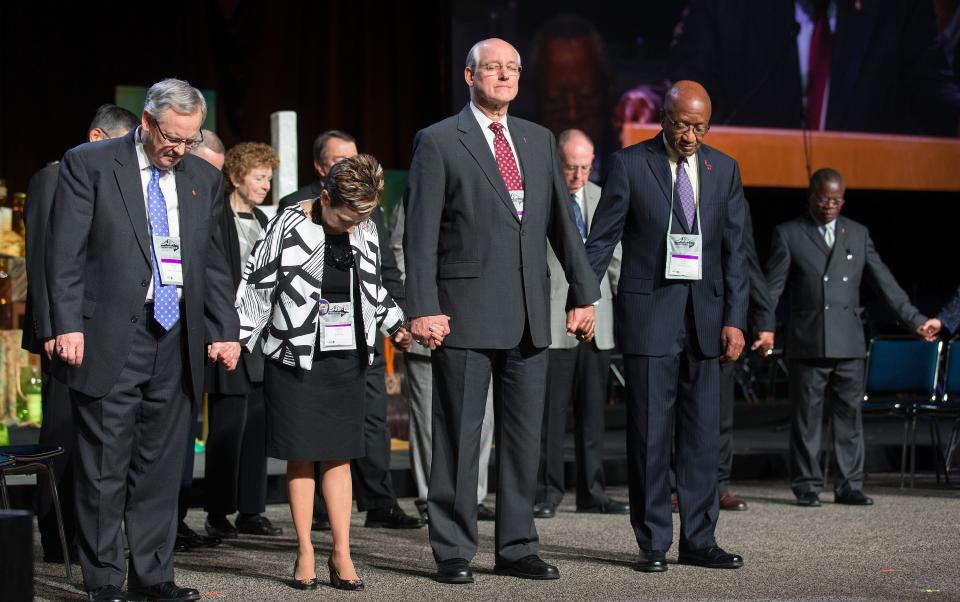The United Methodist Church losing a quarter of its churches in five years is just the start.
The organization’s budget is shrinking, too, as the denomination grapples with the exit of more than 7,600 churches amid divisions over LGBTQ+ rights.
A spending plan being proposed to the upcoming UMC General Conference — the group’s top legislative assembly, which meets every four years — is $23.8 million less than the last one and more than $140 million less than the one recommended in 2019, when congregations began leaving.
The proposed budget recommends 17 fewer bishops to prevent one of the denomination’s funds from running a deficit. Regional conference staff overseen by the bishops has already faced cuts and a consolidation of administrative duties.
The upcoming UMC General Conference, beginning April 22 in Charlotte, North Carolina, is a long-awaited and unquestionably consequential summit. The international delegation is meeting for a regular session for the first time in eight years, a time in which conservatives led an exodus out of the United Methodist Church following disagreements about theology and church policy, including dealing with LGBTQ+ rights.
The Charlotte gathering will be the first step in a new chapter for the largely Nashville, Tennessee-based UMC, the largest mainline Protestant denomination in the United States. Many United Methodists are optimistic about that future, though they also recognize hardships await on their journey.
Here are key takeaways from the financial fallout.
Mass exodus: A quarter of Methodist congregations abandon the church as schism grows over LGBTQ+ issues
Disaffiliations disrupt budget estimates
Churches leaving the denomination, or disaffiliating, had the single greatest effect on budget projections, often causing UMC finance officials to revisit and recalculate earlier estimates.
When disaffiliations started in 2019, finance officials were recommending a $493.8 million budget, or a 17% reduction from the $604 million budget approved by the UMC General Conference in 2016. The new budget was set to come before the UMC General Conference at its regular session in 2020, which the COVID-19 pandemic ultimately pushed back to this year.
Both the general conference delays and steady increase in disaffiliations compounded and by 2022, finance officials were recommending a $373.7 million budget, or a 38% reduction. At that point, total disaffiliations were around 1,800.
By the end of 2023, disaffiliations amounted to more than 7,500 churches. Now, finance officials are recommending a $346.7 million budget, or a 43% reduction.
Regional level faces heat earlier (and unevenly)
So far, the measurable cost to United Methodism’s splintering is most noticeable at the regional level.
Funding for United Methodist regional conference operations, including rank-and-file administrative staff (except bishops), originates from church giving. A percentage of that funding then goes to the denomination’s seven general funds, which comprise the denomination’s budget and support United Methodist general agencies and other national and international organizations.

Regional conferences, called annual conferences, in the U.S. are already dealing with the fallout of the splintering.
There are 53 annual conferences in the U.S., at least 25 of which enacted administrative reductions in the past four years, according to an analysis of news reports. Reductions at those 25 annual conferences were often staff or districts — a local grouping of churches within an annual conference — often meaning a reduction in the number of district superintendent staff positions. At least four other annual conferences announced anticipated reductions later this year or next year.
Annual conferences are the first to feel the financial heat because they approve disaffiliations, but not every annual conference felt it the same.
The five annual conferences in Texas saw 42% of total churches disaffiliate and 45% of all churches in Georgia’s two annual conferences disaffiliated, according to an analysis of data published by the Lewis Center for Church Leadership. In contrast, 1% of total churches disaffiliated in the two annual conferences that encompass California.
“Conferences that have been affected more by disaffiliation and church closures will see their apportionments decline at a higher rate,” said Rick King, chief financial officer for the UMC General Council on Finance & Administration, in a March 1 delegate orientation presentation.
Churches outside the U.S. are so far barred from disaffiliating, though some have left the denomination on their own accord.
Preemptive and future cuts, fewer bishops proposed
Unlike annual conference staff, bishops receive their salaries from one of the denomination’s general funds.
That fund, called the episcopal fund, is facing a recommended 15% reduction in the proposed budget to the upcoming UMC General Conference.
“The fund will run a deficit in the near future if all bishops are elected,” said the Rev. Moses Kumar, general secretary of the UMC General Council on Finance & Administration, in a March 1 delegate orientation presentation. There are currently 71 total bishops worldwide, and the UMC General Council on Finance & Administration is recommending that drop to 54 in the next four years.


A mandatory retirement policy for bishops will help shrink that roster. Meanwhile, many of the bishops who remain will take on additional responsibilities. There are 12 bishops that oversee more than one annual conference, according to the UMC General Council on Finance & Administration. More bishops are expected to do the same in the future.
The budget’s other general funds support 10 of 13 United Methodist general agencies that manage denomination business and oversee its ministries. Most of those general agencies face recommended cuts of at least 30% in the proposed budget — including Nashville-based United Methodist Communications, United Methodist Men, UMC General Council on Finance & Administration and the UMC General Board of Higher Education & Ministry.
Many general agencies started cutting costs years ago. Since 2019, seven general agencies cut at least 130 staff, according to an analysis of news reports. Another common move was selling and consolidating office space. Whereas many of the Nashville-based UMC general agencies each had their own office, they all merged into two buildings.
Liam Adams covers religion for The Nashville Tennessean, part of the USA TODAY Network. Reach him at [email protected] or on social media @liamsadams.
This article originally appeared on Nashville Tennessean: UMC general conference 2024: Millions lost in recent budget proposal
Source Agencies



